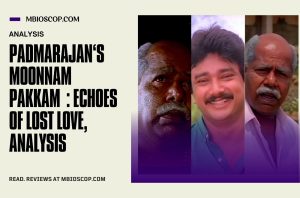The climax scene of “Nanpakal Nerathu Mayakkam,” directed by Lijo Jose Pellisseri and produced by Mammootty Kampany with Amen Movie Monastery as co-producer, unfolds through two conflicting perspectives. Starring Mammootty, Ramya Suvi, Ramya Pandian, and Ashokan, the film delves into themes of insomnia and spiritualism.
1. James’s body became inhabited by the Soul of Sundharam
To provide a clearer understanding, let’s elaborate on our interpretation. James, having dozed off on a bus, abruptly woke up and instructed the driver to halt. Subsequently, he embarked on a stroll into a village, where he inexplicably assumed the persona of Sundharam. This sudden shift in behavior left the other characters, James’s family members, and the audience perplexed, as they grappled with the unexpected and abrupt transformation.
He is fully immersed in the character of Sundharam, with no trace of James evident in his demeanor. In the initial segment of the film, as James checks out from the hotel, he engages in a conversation with the cashier about a Thirukkural quote: “When we are asleep, it is like death, and upon awakening, it is like being reborn.” Much like this Thirukkural, after his sleep, James transforms into Sundaram. Sundaram, an ordinary Tamil individual, had passed away two years ago.
Sundaram’s soul seeks to reconnect with his family through the guise of James. Initially, Sundaram’s family rejects this unfamiliar embodiment, but eventually, they come to recognize it as Sundaram. The presence of the soul is symbolized by the appearance of crows in certain scenes. In a striking acting scene featuring Mammotty at a barber shop, upon glimpsing his reflection in the mirror, he abruptly realizes that he is not Sundaram. It’s conceivable that even Sundaram’s soul is experiencing the revelation that it is distinct from Sundaram.

After having a meal with his daughter, he steps outside, and as he walks, his elongated shadow remains behind. This could symbolize Sundaram’s lingering presence within his home, seemingly departing from James’s physical form. Subsequently, he drifts into a peaceful slumber, during which he unexpectedly envisions Sundaram. Upon awakening, he reverts to being James and rejoins his family.

2. James is Dreaming the entire scenes
This perspective outshines the initial one by conveying a heightened sense of reality. Following the cashier’s recitation of the ‘Thirukkural,’ James absorbs this thought before succumbing to sleep. In his slumber, assuming the role of a dramatic actor, James dreams the entire scene, and it is through this lens that we are immersed in the unfolding narrative. To fortify this concept, we will substantiate it with supporting facts.
Many scenes are captured with static shots, reminiscent of a theatrical sequence. In the bus, old songs play, possibly the same ones we hear in Sundaram’s scenes. To enhance the scene’s justification, the director incorporates shots of Sundaram’s mother watching TV, mirroring the captured moments. This serves as evidence supporting the notion that James is experiencing a dream within his subconscious, as he hears those old songs. Furthermore, in Sundaram’s scenes, certain locations exhibit audible sounds, particularly evident in the mirror scene. This sound originates from the bus mirror, as depicted in a prior shot by the director.

This specific moment clearly shows that the entire situation originated from James’s dream.












